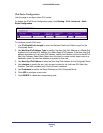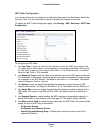
Routing
220
ProSafe M5300 Switch
3. Use Subnet Mask to enter the Subnet Mask to be configured for the VLAN Routing
Interface.
4. Click ADD to add the VLAN Routing Interface specified in the VLAN ID field to the switch
configuration.
5. Click DELETE to remove the VLAN Routing Interface specified in the VLAN ID field from the
switch configuration.
Field Description
Port The interface assigned to the VLAN for routing.
MAC Address The MAC Address assigned to the VLAN Routing Interface
ARP
The ARP protocol associates a layer 2 MAC address with a layer 3 IPv4 address. ProSafe
software features both dynamic and manual ARP configuration. With manual ARP
configuration, you can statically add entries into the ARP table.
ARP is a necessary part of the internet protocol (IP) and is used to translate an IP address to
a media (MAC) address, defined by a local area network (LAN) such as Ethernet. A station
needing to send an IP packet must learn the MAC address of the IP destination, or of the next
hop router, if the destination is not on the same subnet. This is achieved by broadcasting an
ARP request packet, to which the intended recipient responds by unicasting an ARP reply
containing its MAC address. Once learned, the MAC address is used in the destination
address field of the layer 2 header prepended to the IP packet.
The ARP cache is a table maintained locally in each station on a network. ARP cache entries
are learned by examining the source information in the ARP packet payload fields, regardless
of whether it is an ARP request or response. Thus, when an ARP request is broadcast to all
stations on a LAN segment or virtual LAN (VLAN), every recipient has the opportunity to store
the sender’s IP and MAC address in their respective ARP cache. The ARP response, being
unicast, is normally seen only by the requestor, who stores the sender information in its ARP
cache. Newer information always replaces existing content in the ARP cache.
The number of supported ARP entries is platform-dependent.
Devices can be moved in a network, which means the IP address that was at one time
associated with a certain MAC address is now found using a different MAC, or may have
disappeared from the network altogether (i.e., it has been reconfigured, disconnected, or
powered off). This leads to stale information in the ARP cache unless entries are updated in
reaction to new information seen on the network, periodically refreshed to determine if an
address still exists, or removed from the cache if the entry has not been identified as a sender
of an ARP packet during the course of an ageout interval, usually specified via configuration.
From the ARP link, you can access the following pages:
• Basic on page 221
• Advanced on page 221


















